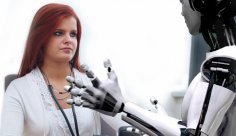
(Image credit: da-cook/Getty Images)
Scientists have developed a device that allows quantum processors to communicate directly with each other, a major step toward creating practical quantum computers. It could provide both faster and less error-prone communication between processors.
Current quantum architecture offers only limited communication capabilities between individual quantum processing units (QPUs). This communication is point-to-point, meaning that information must travel through a chain of multiple nodes before reaching its destination. This increases the likelihood that noise will affect quantum information and increases the risk of errors.
But a new device developed by MIT researchers enables all-to-all communication, allowing all processors on a single network to directly connect to any other processor. The researchers described their “remote entanglement” method in a new study published March 21 in the journal Nature Physics.
Remote entanglement is a state in which two particles share the same state, and changes in one are immediately reflected in the other. The distance between them can be enormous, and there are currently no known limits.
In testing, the scientists linked two quantum processors using modules, each made up of four qubits. Some qubits in each module were dedicated to sending photons, particles of light that can be used to transmit quantum data, while others were dedicated to storing data.
The modules were connected to each other by a superconducting wire called a waveguide, with the modules serving as an interface between larger quantum processors and the waveguide. The scientists noted that any number of processors could be connected in this way, creating a highly scalable network.
The researchers then used microwave pulses to cause a single qubit to emit photons in any direction along the waveguide.
“By transmitting and trapping photons, we can create 'quantum entanglements' between non-local quantum processors, and with quantum entanglements comes remote entanglement,” senior author William D. Oliver, associate director of MIT's Research Laboratory of Electronics, said in a statement.
Photon distortion
Entanglement is a state in which two particles become linked and exchange information, even over large distances. A change in one entangled particle will instantly affect its partner. This is a critical phenomenon for quantum computing because it allows qubits to correlate and function as a single system. This, in turn, makes it possible to create algorithms that are impossible to implement on classical computers.
However, simply moving photons between modules does not automatically create entanglement. To achieve this, the team had to specially prepare both the qubits and the photon so that after being moved, the modules would share a single photon.
To get the two modules to share the same photon, they had to interrupt the pulses halfway through. This essentially meant that half of the photon was absorbed at the receiving end, and the other half remained in the emitting module.
The problem with this method is that the photon is distorted as it passes through the waveguide, which can affect absorption and break entanglement. To overcome this architectural flaw, the team had to distort the photons to promote maximum absorption. By distorting the photons before transmission, they were able to increase the absorption rate to 60%, which is enough to ensure entanglement.
Lead author of the study, Aziza Almanakli, a graduate student in the Department of Electrical Engineering and Computer Science, said the work has broad applications in practical quantum computing.
“In essence, our remote entanglement generation protocol can be adapted for other types of quantum computers and larger-scale quantum internet systems,” Almanakli said.
TOPICS quantum computers
Sourse: www.livescience.com





